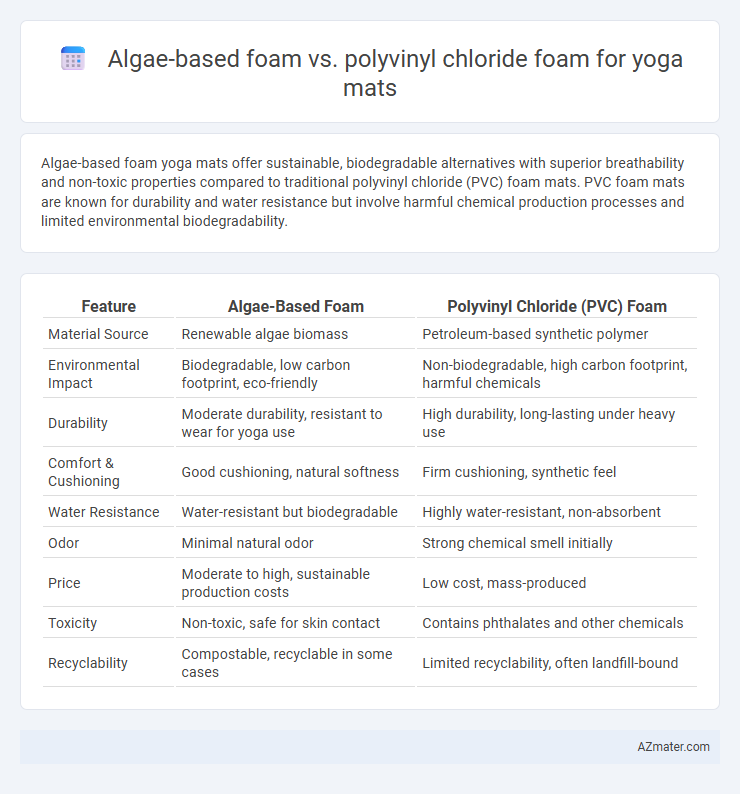Algae-based foam yoga mats offer sustainable, biodegradable alternatives with superior breathability and non-toxic properties compared to traditional polyvinyl chloride (PVC) foam mats. PVC foam mats are known for durability and water resistance but involve harmful chemical production processes and limited environmental biodegradability.
Table of Comparison
| Feature | Algae-Based Foam | Polyvinyl Chloride (PVC) Foam |
|---|---|---|
| Material Source | Renewable algae biomass | Petroleum-based synthetic polymer |
| Environmental Impact | Biodegradable, low carbon footprint, eco-friendly | Non-biodegradable, high carbon footprint, harmful chemicals |
| Durability | Moderate durability, resistant to wear for yoga use | High durability, long-lasting under heavy use |
| Comfort & Cushioning | Good cushioning, natural softness | Firm cushioning, synthetic feel |
| Water Resistance | Water-resistant but biodegradable | Highly water-resistant, non-absorbent |
| Odor | Minimal natural odor | Strong chemical smell initially |
| Price | Moderate to high, sustainable production costs | Low cost, mass-produced |
| Toxicity | Non-toxic, safe for skin contact | Contains phthalates and other chemicals |
| Recyclability | Compostable, recyclable in some cases | Limited recyclability, often landfill-bound |
Introduction to Yoga Mat Materials
Algae-based foam offers a sustainable alternative to traditional polyvinyl chloride (PVC) foam commonly used in yoga mats, featuring biodegradable and non-toxic properties that reduce environmental impact. PVC foam, characterized by its durability, flexibility, and moisture resistance, remains popular but raises concerns due to its chemical composition and potential off-gassing of harmful substances. Emerging trends in yoga mat materials prioritize eco-friendly options like algae foam, which support both performance and environmental wellness in yoga practice.
Basics of Algae-Based Foam
Algae-based foam is a sustainable alternative to traditional Polyvinyl chloride (PVC) foam used in yoga mats, composed primarily of algae biomass combined with natural latex or bio-based polymers. This eco-friendly material offers biodegradability, non-toxic properties, and enhanced cushioning performance, providing both environmental benefits and user comfort. Unlike PVC foam, which relies on synthetic chemicals and plasticizers, algae-based foam reduces carbon footprint and water pollution, making it ideal for eco-conscious consumers.
Understanding Polyvinyl Chloride (PVC) Foam
Polyvinyl chloride (PVC) foam is a widely used material in yoga mats, known for its durability, cushioning, and resistance to moisture. PVC foam consists of a closed-cell structure that provides excellent shock absorption and support during yoga practice, making it a popular choice among athletes. However, its non-biodegradable nature and potential environmental impact have led to increased interest in sustainable alternatives like algae-based foam.
Environmental Impact: Algae-Based vs PVC Foam
Algae-based foam for yoga mats significantly reduces carbon footprint by utilizing renewable biomass sources, whereas polyvinyl chloride (PVC) foam relies on fossil fuels and emits toxic chemicals during production and disposal. The biodegradable nature of algae foam minimizes landfill waste and aquatic pollution, contrasting with PVC's persistence and harmful leachates in ecosystems. Choosing algae-based foam supports sustainable manufacturing and decreases long-term environmental hazards associated with conventional PVC materials.
Durability and Longevity Comparison
Algae-based foam yoga mats offer enhanced biodegradability while maintaining comparable durability to polyvinyl chloride (PVC) foam mats, resisting tears and compression over extended use. PVC foam mats typically provide superior longevity due to their dense structure and resistance to wear, although they pose environmental concerns related to non-biodegradability and chemical leaching. Choosing algae-based foam supports eco-friendly practices without significantly compromising lifespan, whereas PVC mats remain preferred for heavy-duty durability and resilience in high-frequency yoga practice.
Comfort and Cushioning: User Experience
Algae-based foam offers superior breathability and resilience, providing enhanced cushioning and moisture management that elevates user comfort during extended yoga sessions. Polyvinyl chloride (PVC) foam tends to deliver firm support but may trap heat and moisture, potentially causing discomfort over time. Users report that algae-based foam mats conform better to body contours, reducing pressure points and improving overall ergonomic experience.
Health and Safety Considerations
Algae-based foam yoga mats offer a non-toxic, hypoallergenic alternative to polyvinyl chloride (PVC) foam mats, reducing exposure to harmful chemicals such as phthalates and volatile organic compounds (VOCs) commonly found in PVC. The natural composition of algae foam enhances biodegradability and lowers respiratory irritation risks, promoting a healthier indoor environment during workouts. In contrast, PVC foam mats may off-gas toxic substances over time, posing potential health hazards including skin sensitivity and respiratory issues for sensitive users.
Cost Evaluation and Market Availability
Algae-based foam yoga mats generally present higher initial production costs compared to polyvinyl chloride (PVC) foam mats due to the sourcing and processing of bio-based materials, impacting retail prices. PVC foam mats dominate the market with widespread availability and lower manufacturing expenses, benefiting from established supply chains and economies of scale. Consumer demand for sustainable alternatives is driving gradual increases in algae-based foam production, but market availability remains limited relative to PVC foam options.
Sustainability and Biodegradability
Algae-based foam offers superior sustainability compared to polyvinyl chloride (PVC) foam by utilizing renewable resources and reducing reliance on fossil fuels, thereby lowering carbon emissions during production. Its biodegradability ensures minimal environmental impact at the end of the yoga mat's life cycle, breaking down naturally without releasing toxic substances. In contrast, PVC foam is derived from non-renewable petroleum, persists in landfills for centuries, and poses significant environmental hazards due to its slow degradation and potential release of harmful chemicals.
Choosing the Best Yoga Mat: Algae-Based or PVC Foam
Algae-based foam yoga mats offer eco-friendly benefits with biodegradability and reduced environmental impact compared to traditional polyvinyl chloride (PVC) foam mats, which are durable but involve harmful chemical production. The moisture-wicking and antimicrobial properties of algae-based mats enhance hygiene and comfort during intense yoga sessions. PVC foam mats excel in cushioning and durability, but choosing algae-based foam supports sustainability and non-toxic materials for health-conscious yogis.

Infographic: Algae-based foam vs Polyvinyl chloride foam for Yoga mat
 azmater.com
azmater.com